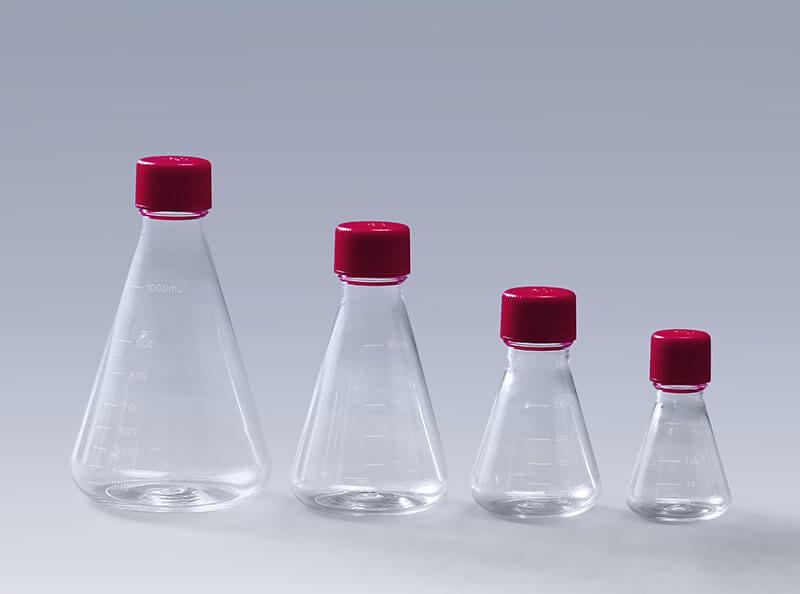Cell shaker flasks are versatile laboratory consumables designed for both cell culture and the storage of culture media. This article will explore the critical steps involved in using these flasks during the preparation of culture media.
I. Steps in Preparing Culture Media
In cell culture, the culture medium provides essential nutrients for cell growth. The following is a detailed process of how to prepare culture media using cell shaker flasks:
Ingredient Preparation
Step: Add a small amount of water to the cell shaker flask and measure out the required chemicals according to the preset formula. After adding sufficient water, ensure that the bottle cap is immediately sealed after each ingredient is added to maintain the stability and purity of the chemicals.
Dissolving Starch
Step: Dissolve starch by mixing it with a small amount of cold water to form a paste, then heat until fully dissolved. For media containing agar, boiling is required, as agar melts at 95-97°C. Stir constantly during heating to prevent the agar from scorching.
Adjusting pH
Step: Use 1N hydrochloric acid (HCl) or 1N sodium hydroxide (NaOH) to adjust the pH of the medium to the desired range. The accuracy of the pH level is crucial for the effectiveness of the culture medium.

Filtration
Step: Filter the medium using filter paper or cotton to remove any solid particles or impurities. This step helps ensure the purity of the culture medium.
Dispensing
Step: Dispense the filtered medium into cell shaker flasks in preparation for sterilization. At this stage, the medium is usually placed in triangular cell shaker flasks for the next process.
Sterilization
Step: Sterilize the culture medium using an autoclave under the required temperature and pressure. The sterilization conditions must be carefully controlled to avoid damaging the nutrients in the medium. Excessive temperature can cause the medium to darken, indicating nutrient degradation.
Creating Slants
Step: After sterilization, slant the test tubes while hot to allow the medium to solidify at an angle. The slant should occupy about half of the test tube’s length, facilitating later culture operations.
Storage
Step: Place the prepared medium at 30°C for a day to check for contamination. If contamination is absent, wrap the medium in paper and store it in a refrigerator at 2-8°C for later use. Pay attention to the storage time and conditions to prevent the medium from deteriorating or becoming contaminated.
II. Key Considerations
Choosing the Right Materials:
Select the appropriate material for the cell shaker flasks and lids based on the experimental requirements. PC and PETG materials have distinct characteristics, and the selection should be made according to the experimental conditions.
Sterilization Control:
During sterilization, ensure precise control of temperature and pressure to avoid damaging the components of the culture medium.
Proper Storage:
The storage conditions of the culture medium directly affect its efficacy and shelf life. Ensure the medium is stored at the proper temperature and regularly check its condition.
Conclusion
Cell shaker flasks play a crucial role in both cell culture and the preparation of culture media. Understanding their preparation process and key considerations can help researchers optimize their experimental workflows and improve the reliability and effectiveness of their experiments.
The FAI climbed 5.9 percent year-on-year in the first 11 months of 2018, quickening from the 5.7-percent growth in Jan-Oct, the National Bureau of Statistics (NBS) said Friday in an online statement.
The key indicator of investment, dubbed a major growth driver, hit the bottom in August and has since started to rebound steadily.
In the face of emerging economic challenges home and abroad, China has stepped up efforts to stabilize investment, in particular rolling out measures to motivate private investors and channel funds into infrastructure.
Friday's data showed private investment, accounting for more than 60 percent of the total FAI, expanded by a brisk 8.7 percent.
NBS spokesperson Mao Shengyong said funds into weak economic links registered rapid increases as investment in environmental protection and agriculture jumped 42 percent and 12.5 percent respectively, much faster than the average.
In breakdown, investment in high-tech and equipment manufacturing remained vigorous with 16.1-percent and 11.6-percent increases respectively in the first 11 months. Infrastructure investment gained 3.7 percent, staying flat. Investment in property development rose 9.7 percent, also unchanged.
 English
English


















































